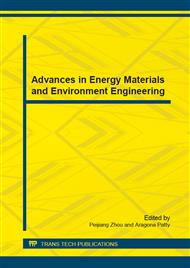[1]
H. Jüntgen. Carbon, 15 (1977) p.273.
Google Scholar
[2]
R. Leboda, J. Skubiszewska-Zięba and W. Grzegorczyk. Carbon, 36 (1998) p.417.
Google Scholar
[3]
O. Barbieri, M. Hahn, A. Herzog and R. Kötz. Carbon, 43 (2005) p.1303.
Google Scholar
[4]
R. Ryoo, S. H. Joo, M. Kruk and M. Jaroniec. Adv. Mater., 13 (2001) p.677.
Google Scholar
[5]
S. A. Al-Muhtaseb and J. A. Ritter. Adv. Mater., 15 (2003) p.101.
Google Scholar
[6]
J. Lee, J. Kim and T. Hyeon. Adv. Mater., 18 (2006) p. (2073).
Google Scholar
[7]
I. Tanahashi. J. Appl. Electrochem., 35 (2005) p.1067.
Google Scholar
[8]
Bin Xu, Feng Wu, Shi Chen, Cunzhong Zhang, Gaoping Cao and Yusheng Yang. Electrochem. Acta, 52 (2007) p.4595.
Google Scholar
[9]
Lan-Ying Xu, Zhi-Guo Shi and Yu-Qi Feng. Microporous and Mesoporous Materials, 115 (2008) p.618.
Google Scholar
[10]
Zhi-Guo Shi, Yu-Qi Feng, Li Xu, Shi-Lu Da and Ming Zhang. Carbon, 41 (2003) p.2677.
Google Scholar
[11]
Sonia Álvarez and Antonio B. Fuertes. Materials Letters, 61 (2007) p.2378.
Google Scholar
[12]
Lifeng Wang, Sen Lin, Kaifeng Lin, Chengyang Yin, Desheng Liang, Yan Di, Peiwei Fan, Dazhen Jiang and Feng-Shou Xiao. Microporous and Mesoporous Materials, 85 (2005) p.136.
Google Scholar
[13]
Zhi-Guo Shi, Yu-Qi Feng, Li Xu, Shi-Lu Da and Min Zhang. Carbon, 42 (2004) p.1677.
Google Scholar
[14]
Pingyun Feng, Xianhui Bu, Galen D. Stucky and David J. Pine. J. Am. Chem. Soc., 122 (2000) p.994.
Google Scholar
[15]
N. A. Melosh, P. Davidson and B. F. Chmelka. J. Am. Chem. Soc., 122 (2000) p.823.
Google Scholar
[16]
Christine G. Göltner, Susanne Henke, Markus C. Weissenberger and Markus Antonietti. Angew. Chem. Int. Ed, 37 (1998) p.613.
Google Scholar
[17]
Haifeng Yang, Qihui Shi, Bozhi Tian, Songhai Xie, Fuqiang Zhang, Yan Yan, Bo Tu and Dongyuan Zhao. Chem. Mater., 15(2003) p.536.
Google Scholar
[18]
Nattaporn Tonanon, Adisak Siyasukh, Yunyong Wareenin, Tawatchai Charinpanitkul, Wiwut Tanthapanichakoon, Hirotomo Nishihara, Shin R. Mukai and Hajime Tamon. Carbon, 43 (2005) p.2808.
DOI: 10.1016/j.carbon.2005.05.026
Google Scholar
[19]
Adisak Siyasukh, Patompong Maneeprom, Siriporn Larpkiattaworn, Nattaporn Tonanon, Wiwut Tanthapanichakoon, Hajime Tamon and Tawatchai Charinpanitkul. Carbon, 46 (2008) p.1309.
DOI: 10.1016/j.carbon.2008.05.006
Google Scholar
[20]
Hsisheng Teng and Sheng-Chi Wang. Carbon, 38 (2000) p.817.
Google Scholar
[21]
M.S. Chandrasekar and Malathy Pushpavanam. Electrochimica Acta, 53 (2008) p.3313.
Google Scholar
[22]
Dong Chen, Jie Cheng, Yuehua Wen, Junqing Pan, Gaoping Cao and Yusheng Yang. Journal of The Electrochemical Society, 158 (2011) p. A1303.
Google Scholar


